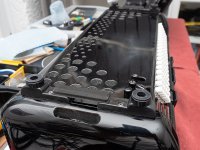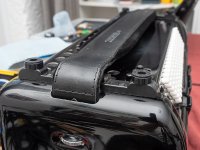Ventura
Been here for ages!
well a few threads have touched on things like marking bass buttons
and how to master jumps and such, so i wanted to offer how my teacher taught
me to do it
Bob Homovich, Pittsburgh PA. (Jazz man through and through) played an AC
so he would assign me a song from Fake Book one each week and i had to
make lines on a paper, re-write out the song, then fill in full Chords for every
melody note etc. before i even attempted to play it
the objective in playing full chords for each note was to absorb them into my DNA
but when performing the song, to just use the chords that you want to of course.
where the Bass stuff comes in is that one week he assigned me the Rhumba,
"Temptation"
it probably took me at least a whole month to get this one down so it
didn't sound butchered with mistakes, and then he would make me play it
once every lesson for like the whole summer just to make sure i kept
practicing it
you see, Temptation has more bass jumps, huge bass jumps, serious
bass progressions, major to minor counters, all over the map !
i never encountered another song quite like this and have to say
if YOU follow this lead, and fight your way through this number,
you gonna be able to do any left hand jump for the rest of your life
i mean it worked on me, and i am no rocket scientist,
so it should work for you too
and how to master jumps and such, so i wanted to offer how my teacher taught
me to do it
Bob Homovich, Pittsburgh PA. (Jazz man through and through) played an AC
so he would assign me a song from Fake Book one each week and i had to
make lines on a paper, re-write out the song, then fill in full Chords for every
melody note etc. before i even attempted to play it
the objective in playing full chords for each note was to absorb them into my DNA
but when performing the song, to just use the chords that you want to of course.
where the Bass stuff comes in is that one week he assigned me the Rhumba,
"Temptation"
it probably took me at least a whole month to get this one down so it
didn't sound butchered with mistakes, and then he would make me play it
once every lesson for like the whole summer just to make sure i kept
practicing it
you see, Temptation has more bass jumps, huge bass jumps, serious
bass progressions, major to minor counters, all over the map !
i never encountered another song quite like this and have to say
if YOU follow this lead, and fight your way through this number,
you gonna be able to do any left hand jump for the rest of your life
i mean it worked on me, and i am no rocket scientist,
so it should work for you too


